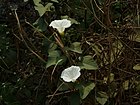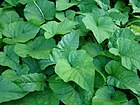Note: This is a project under development. The articles on this wiki are just being initiated and broadly incomplete. You can Help creating new pages.
Difference between revisions of "Operculina turpethum - Trivrit"
(→How to plant/cultivate) |
(→External Links) |
||
| (3 intermediate revisions by 2 users not shown) | |||
| Line 1: | Line 1: | ||
[[File:Nisottar (Marathi- निसोत्तर) (368809786).jpg|thumb|right|''Trivrit'', ''Operculina turpethum'']] | [[File:Nisottar (Marathi- निसोत्तर) (368809786).jpg|thumb|right|''Trivrit'', ''Operculina turpethum'']] | ||
| − | '''Trivrit'''is a climber in the morning glory family with white flowers. It can be found throughout India | + | '''Trivrit'''is a climber in the morning glory family with white flowers. It can be found throughout India. |
| − | |||
==Uses== | ==Uses== | ||
{{Uses|Constipation}}, {{Uses|Worm infestation}}, {{Uses|Inflammation}}, {{Uses|Spleen diseases}}, {{Uses|Heart disorders}}, {{Uses|Bloating}} | {{Uses|Constipation}}, {{Uses|Worm infestation}}, {{Uses|Inflammation}}, {{Uses|Spleen diseases}}, {{Uses|Heart disorders}}, {{Uses|Bloating}} | ||
| Line 11: | Line 10: | ||
==Common names== | ==Common names== | ||
| − | {{Common names|kn= | + | {{Common names|kn=Alutigade, Bili tigade, Aluthi gida, Bangada balli|ml=Sivata, Chivaka, Trikolpakkonna|sa=Ardhachandra, Arunatrivrt, Tribhandi, Sarala|ta=Adimbu, Saralam, Kumbham, Shivadai-ver|te=Erra tegada, Nalla tegada|hi=Nisotar, Nisoth, Nukpatar, Tarbut|en=Turpeth root}} |
<ref name="Common names"/> | <ref name="Common names"/> | ||
| Line 35: | Line 34: | ||
==Identification== | ==Identification== | ||
===Leaf=== | ===Leaf=== | ||
| − | {{Leaf|Simple| | + | {{Leaf|Simple|Alternate|Leaves alternate, broadly ovate, 5-10 by 4-8.5 cm, base cordate, apex acute or obtuse, mucronate, thinly pubescent; petiole 2-7 cm long.}}<ref name="Leaf"/> |
===Flower=== | ===Flower=== | ||
| Line 41: | Line 40: | ||
===Fruit=== | ===Fruit=== | ||
| − | {{Fruit|A capsule|Ovoid| | + | {{Fruit|A capsule|Ovoid|Seeds glabrous|}} |
===Other features=== | ===Other features=== | ||
| Line 57: | Line 56: | ||
==How to plant/cultivate== | ==How to plant/cultivate== | ||
| − | + | The plants can be raised by vegetative propagation as well as from seeds. Best method for raising the plants is to use vegetative cuttings of length 10 cm, which should have two nodes.<ref name="Cultivation details"/> | |
| − | The plants can be raised by vegetative propagation as well as from seeds. Best method for raising the plants is to use vegetative cuttings of length 10 cm, which should have two nodes | ||
==Commonly seen growing in areas== | ==Commonly seen growing in areas== | ||
| Line 77: | Line 75: | ||
<references> | <references> | ||
| − | <ref name="Uses">[https://easyayurveda.com/2014/03/03/trivrit-operculina-turpethum-usage-dose-side-effects/ | + | <ref name="Uses">[https://easyayurveda.com/2014/03/03/trivrit-operculina-turpethum-usage-dose-side-effects/ Uses]</ref> |
| − | <ref name="Leaf">[http://FLOWERING PLANTS OF KERALA VER.2, N. Sasidharan | + | <ref name="Leaf">[http://FLOWERING PLANTS OF KERALA VER.2, N. Sasidharan BOTANIC DESCRIPTION]</ref> |
| − | <ref name="Ayurvedic preparations">[https://easyayurveda.com/2014/03/03/trivrit-operculina-turpethum-usage-dose-side-effects/ | + | <ref name="Ayurvedic preparations">[https://easyayurveda.com/2014/03/03/trivrit-operculina-turpethum-usage-dose-side-effects/ Ayurvedic preparations]</ref> |
| − | <ref name="Common names">[http://envis.frlht.org/bot_search | + | <ref name="Common names">[http://envis.frlht.org/bot_search Vernacular names]</ref> |
| + | <ref name="Cultivation details">[http://vikaspedia.in/agriculture/crop-production/package-of-practices/medicinal-and-aromatic-plants/operculina-turpethum Cultivation details]</ref> | ||
| Line 88: | Line 87: | ||
==External Links== | ==External Links== | ||
| − | * https://www.planetayurveda.com/library/trivrit-operculina-turpethum | + | * [https://www.planetayurveda.com/library/trivrit-operculina-turpethum Operculina turpethum on planetayurveda.com] |
| − | * https://www.ncbi.nlm.nih.gov/pmc/articles/PMC5628523/ | + | * [https://www.ncbi.nlm.nih.gov/pmc/articles/PMC5628523/ Operculina turpethum on www.ncbi.nlm.nih.gov] |
| − | * https://www.google.com/search?q=operculina+turpethum+ayurveda&oq=operculina+turpethum+&aqs=chrome.4.69i57j0l5.8417j0j4&sourceid=chrome&ie=UTF-8 | + | * [https://www.google.com/search?q=operculina+turpethum+ayurveda&oq=operculina+turpethum+&aqs=chrome.4.69i57j0l5.8417j0j4&sourceid=chrome&ie=UTF-8 Operculina turpethum on www.google.com] |
| − | * http://tropical.theferns.info/viewtropical.php?id=Operculina+turpethum | + | * [http://tropical.theferns.info/viewtropical.php?id=Operculina+turpethum Operculina turpethum on tropical.theferns.info] |
[[Category:Herbs]] | [[Category:Herbs]] | ||
[[Category:Convolvulaceae]] | [[Category:Convolvulaceae]] | ||
[[Category:Ayurvedic herbs that don't have seed photos]] | [[Category:Ayurvedic herbs that don't have seed photos]] | ||
Latest revision as of 18:31, 9 June 2020
Trivritis a climber in the morning glory family with white flowers. It can be found throughout India.
Contents
- 1 Uses
- 2 Parts Used
- 3 Chemical Composition
- 4 Common names
- 5 Properties
- 6 Habit
- 7 Identification
- 8 List of Ayurvedic medicine in which the herb is used
- 9 Where to get the saplings
- 10 Mode of Propagation
- 11 How to plant/cultivate
- 12 Commonly seen growing in areas
- 13 Photo Gallery
- 14 References
- 15 External Links
Uses
Constipation, Worm infestation, Inflammation, Spleen diseases, Heart disorders, Bloating [1]
Parts Used
Chemical Composition
Common names
| Language | Common name |
|---|---|
| Kannada | Alutigade, Bili tigade, Aluthi gida, Bangada balli |
| Hindi | Nisotar, Nisoth, Nukpatar, Tarbut |
| Malayalam | Sivata, Chivaka, Trikolpakkonna |
| Tamil | Adimbu, Saralam, Kumbham, Shivadai-ver |
| Telugu | Erra tegada, Nalla tegada |
| Marathi | NA |
| Gujarathi | NA |
| Punjabi | NA |
| Kashmiri | NA |
| Sanskrit | Ardhachandra, Arunatrivrt, Tribhandi, Sarala |
| English | Turpeth root |
Properties
Reference: Dravya - Substance, Rasa - Taste, Guna - Qualities, Veerya - Potency, Vipaka - Post-digesion effect, Karma - Pharmacological activity, Prabhava - Therepeutics.
Dravya
Rasa
Tikta (Bitter), Katu (Pungent)
Guna
Laghu (Light), Rooksha (Dry), Teekshna (Piercing)
Veerya
Ushna (Hot)
Vipaka
Karma
Kapha, Pitta
Prabhava
Rechana (Causes purgation)
Habit
Identification
Leaf
| Kind | Shape | Feature |
|---|---|---|
| Simple | Alternate | Leaves alternate, broadly ovate, 5-10 by 4-8.5 cm, base cordate, apex acute or obtuse, mucronate, thinly pubescent; petiole 2-7 cm long. |
Flower
| Type | Size | Color and composition | Stamen | More information |
|---|---|---|---|---|
| Bisexual | Solitary or few in axillary cymes | White | Flower(s) solitary or few in axillary cymes. Calyx lobes ovate, outer larger, 2 by 1.5 cm, thick coriaceous at age.cCrolla white, c. 3 cm across. Ovary 2-locular. |
Fruit
| Type | Size | Mass | Appearance | Seeds | More information |
|---|---|---|---|---|---|
| A capsule | Ovoid | Seeds glabrous | {{{5}}} | {{{6}}} |
Other features
List of Ayurvedic medicine in which the herb is used
Where to get the saplings
Mode of Propagation
How to plant/cultivate
The plants can be raised by vegetative propagation as well as from seeds. Best method for raising the plants is to use vegetative cuttings of length 10 cm, which should have two nodes.[5]
Commonly seen growing in areas
Photo Gallery
References
External Links
- Ayurvedic Herbs known to be helpful to treat Constipation
- Ayurvedic Herbs known to be helpful to treat Worm infestation
- Ayurvedic Herbs known to be helpful to treat Inflammation
- Ayurvedic Herbs known to be helpful to treat Spleen diseases
- Ayurvedic Herbs known to be helpful to treat Heart disorders
- Ayurvedic Herbs known to be helpful to treat Bloating
- Herbs with Roots used in medicine
- Herbs with Leaves used in medicine
- Herbs with common name in Kannada
- Herbs with common name in Hindi
- Herbs with common name in Malayalam
- Herbs with common name in Tamil
- Herbs with common name in Telugu
- Herbs with common name in Sanskrit
- Herbs with common name in English
- Habit - Climber
- Index of Plants which can be propagated by Seeds
- Index of Plants which can be propagated by Cuttings
- Herbs that are commonly seen in the region of Tropical area
- Herbs
- Convolvulaceae
- Ayurvedic herbs that don't have seed photos





